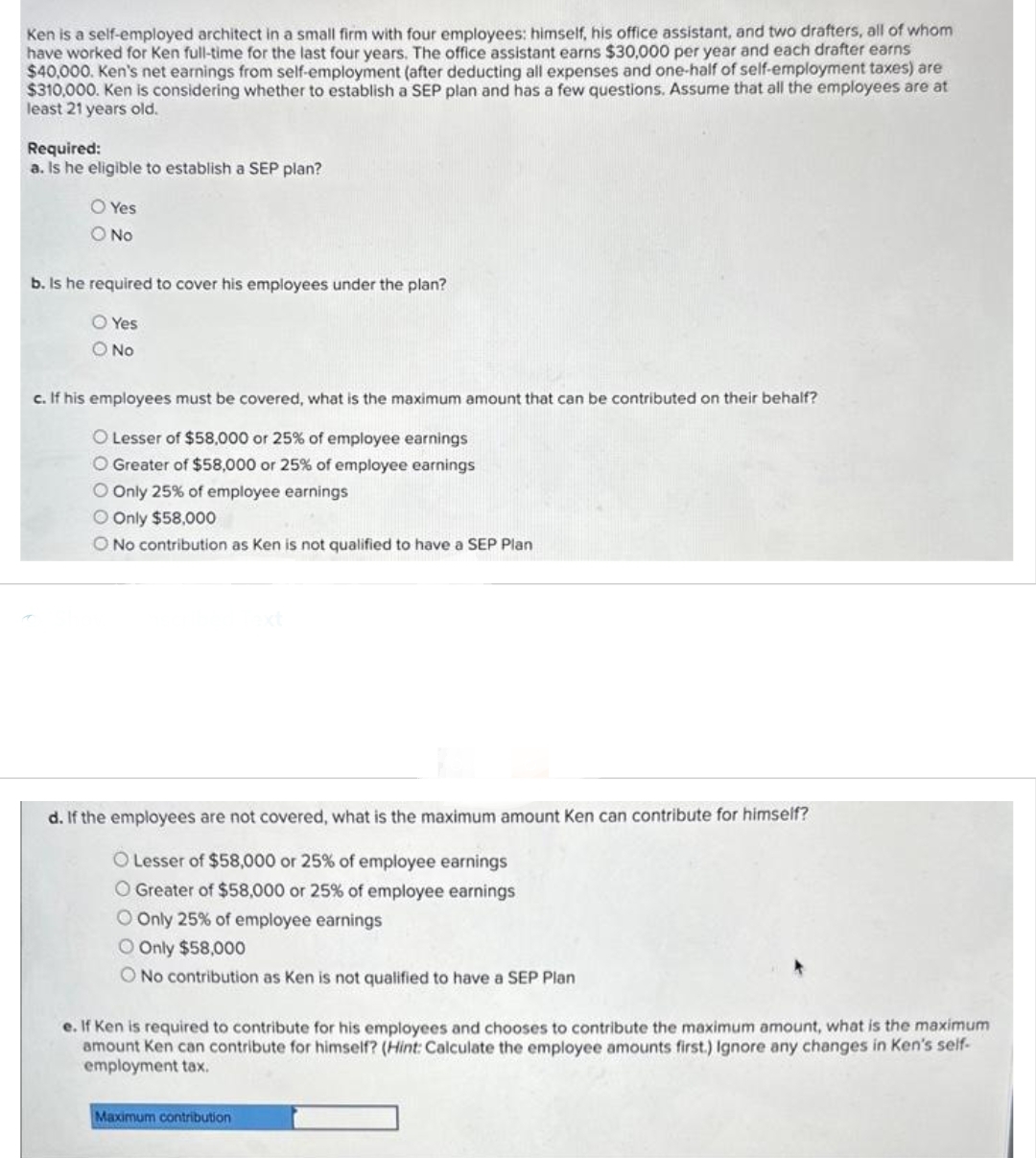Ken is a self-employed architect in a small firm with four employees: himself, his office assistant, and two drafters, all of whom have worked for Ken full-time for the last four years. The office assistant earns $30,000 per year and each drafter earns $40,000. Ken's net earnings from self-employment (after deducting all expenses and one-half of self-employment taxes) are $310,000. Ken is considering whether to establish a SEP plan and has a few questions. Assume that all the employees are at least 21 years old. Required: a. Is he eligible to establish a SEP plan? O Yes O No b. Is he required to cover his employees under the plan? O Yes O No c. If his employees must be covered, what is the maximum amount that can be contributed on their behalf? O Lesser of $58,000 or 25% of employee earnings O Greater of $58,000 or 25% of employee O Only 25% of employee earnings O Only $58,000 O No contribution as Ken is not qualified to have a SEP Plan d. If the employees are not covered, what is the maximum amount Ken can contribute for himself? O Lesser of $58,000 or 25% of employee earnings O Greater of $58,000 or 25% of employee earnings O Only 25% of employee earnings O Only $58,000 O No contribution as Ken is not qualified to have a SEP Plan e. If Ken is required to contribute for his employees and chooses to contribute the maximum amount, what is the maximum amount Ken can contribute for himself? (Hint: Calculate the employee amounts first.) Ignore any changes in Ken's self- employment tax. Maximum contribution
Ken is a self-employed architect in a small firm with four employees: himself, his office assistant, and two drafters, all of whom have worked for Ken full-time for the last four years. The office assistant earns $30,000 per year and each drafter earns $40,000. Ken's net earnings from self-employment (after deducting all expenses and one-half of self-employment taxes) are $310,000. Ken is considering whether to establish a SEP plan and has a few questions. Assume that all the employees are at least 21 years old. Required: a. Is he eligible to establish a SEP plan? O Yes O No b. Is he required to cover his employees under the plan? O Yes O No c. If his employees must be covered, what is the maximum amount that can be contributed on their behalf? O Lesser of $58,000 or 25% of employee earnings O Greater of $58,000 or 25% of employee O Only 25% of employee earnings O Only $58,000 O No contribution as Ken is not qualified to have a SEP Plan d. If the employees are not covered, what is the maximum amount Ken can contribute for himself? O Lesser of $58,000 or 25% of employee earnings O Greater of $58,000 or 25% of employee earnings O Only 25% of employee earnings O Only $58,000 O No contribution as Ken is not qualified to have a SEP Plan e. If Ken is required to contribute for his employees and chooses to contribute the maximum amount, what is the maximum amount Ken can contribute for himself? (Hint: Calculate the employee amounts first.) Ignore any changes in Ken's self- employment tax. Maximum contribution
Chapter6: Business Expenses
Section: Chapter Questions
Problem 33P
Related questions
Question
K2.

Transcribed Image Text:Ken is a self-employed architect in a small firm with four employees: himself, his office assistant, and two drafters, all of whom
have worked for Ken full-time for the last four years. The office assistant earns $30,000 per year and each drafter earns
$40,000. Ken's net earnings from self-employment (after deducting all expenses and one-half of self-employment taxes) are
$310,000. Ken is considering whether to establish a SEP plan and has a few questions. Assume that all the employees are at
least 21 years old.
Required:
a. Is he eligible to establish a SEP plan?
O Yes
O No
b. Is he required to cover his employees under the plan?
O Yes
O No
c. If his employees must be covered, what is the maximum amount that can be contributed on their behalf?
O Lesser of $58,000 or 25% of employee earnings
O Greater of $58,000 or 25% of employee earnings
O Only 25% of employee earnings
O Only $58,000
O No contribution as Ken is not qualified to have a SEP Plan
d. If the employees are not covered, what is the maximum amount Ken can contribute for himself?
O Lesser of $58,000 or 25% of employee earnings
O Greater of $58,000 or 25% of employee earnings
O Only 25% of employee earnings
O Only $58,000
O No contribution as Ken is not qualified to have a SEP Plan
e. If Ken is required to contribute for his employees and chooses to contribute the maximum amount, what is the maximum
amount Ken can contribute for himself? (Hint: Calculate the employee amounts first.) Ignore any changes in Ken's self-
employment tax.
Maximum contribution
Expert Solution
This question has been solved!
Explore an expertly crafted, step-by-step solution for a thorough understanding of key concepts.
This is a popular solution!
Trending now
This is a popular solution!
Step by step
Solved in 2 steps

Recommended textbooks for you







Individual Income Taxes
Accounting
ISBN:
9780357109731
Author:
Hoffman
Publisher:
CENGAGE LEARNING - CONSIGNMENT

